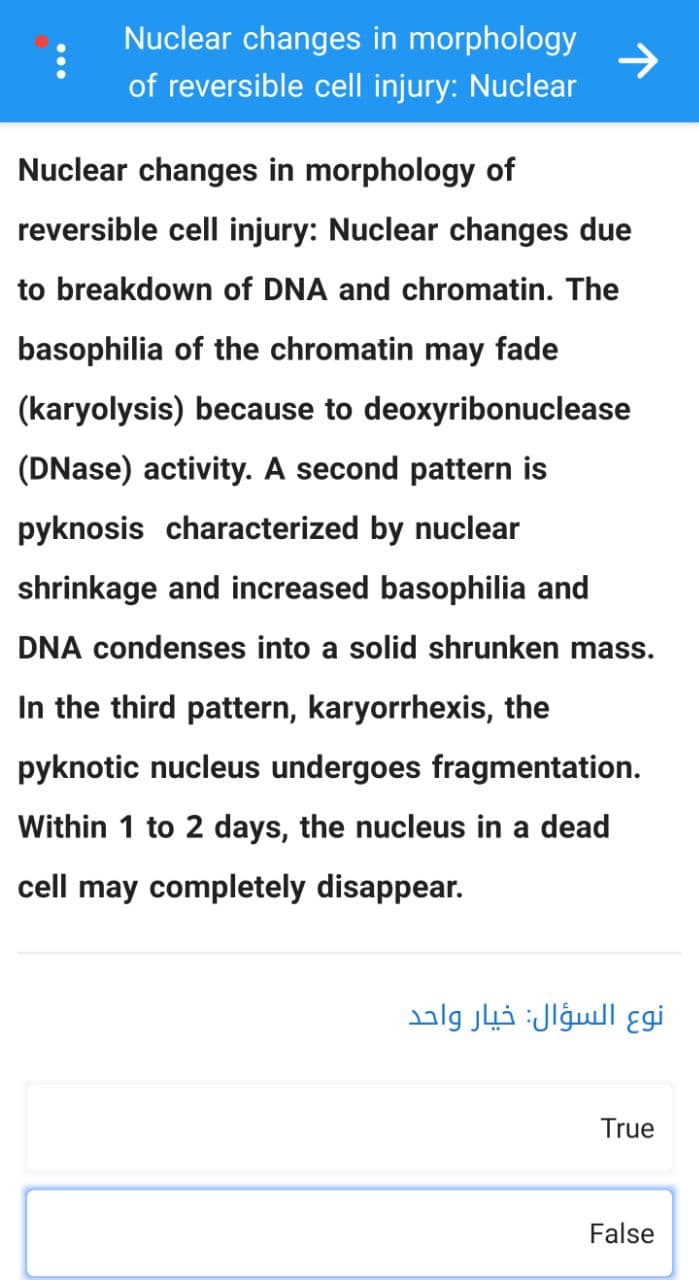: Nuclear changes in morphology of reversible cell injury: Nuclear Nuclear changes in morphology of reversible cell injury: Nuclear changes due to breakdown of DNA and chromatin. The basophilia of the chromatin may fade (karyolysis) because to deoxyribonuclease (DNase) activity. A second pattern is pyknosis characterized by nuclear shrinkage and increased basophilia and DNA condenses into a solid shrunken mass. In the third pattern, karyorrhexis, the pyknotic nucleus undergoes fragmentation. Within 1 to 2 days, the nucleus in a dead cell may completely disappear. نوع السؤال: خيار واحد True False
: Nuclear changes in morphology of reversible cell injury: Nuclear Nuclear changes in morphology of reversible cell injury: Nuclear changes due to breakdown of DNA and chromatin. The basophilia of the chromatin may fade (karyolysis) because to deoxyribonuclease (DNase) activity. A second pattern is pyknosis characterized by nuclear shrinkage and increased basophilia and DNA condenses into a solid shrunken mass. In the third pattern, karyorrhexis, the pyknotic nucleus undergoes fragmentation. Within 1 to 2 days, the nucleus in a dead cell may completely disappear. نوع السؤال: خيار واحد True False
Biology: The Dynamic Science (MindTap Course List)
4th Edition
ISBN:9781305389892
Author:Peter J. Russell, Paul E. Hertz, Beverly McMillan
Publisher:Peter J. Russell, Paul E. Hertz, Beverly McMillan
Chapter10: Cell Division And Mitosis
Section: Chapter Questions
Problem 1ITD: Biologists have long been interested in the effects of radiation on cells. In one experiment,...
Related questions
Question

Transcribed Image Text::
Nuclear changes in morphology
of reversible cell injury: Nuclear
Nuclear changes in morphology of
reversible cell injury: Nuclear changes due
to breakdown of DNA and chromatin. The
basophilia of the chromatin may fade
(karyolysis) because to deoxyribonuclease
(DNase) activity. A second pattern is
pyknosis characterized by nuclear
shrinkage and increased basophilia and
DNA condenses into a solid shrunken mass.
In the third pattern, karyorrhexis, the
pyknotic nucleus undergoes fragmentation.
Within 1 to 2 days, the nucleus in a dead
cell may completely disappear.
نوع السؤال: خيار واحد
True
False
Expert Solution
This question has been solved!
Explore an expertly crafted, step-by-step solution for a thorough understanding of key concepts.
Step by step
Solved in 2 steps

Knowledge Booster
Learn more about
Need a deep-dive on the concept behind this application? Look no further. Learn more about this topic, biology and related others by exploring similar questions and additional content below.Recommended textbooks for you

Biology: The Dynamic Science (MindTap Course List)
Biology
ISBN:
9781305389892
Author:
Peter J. Russell, Paul E. Hertz, Beverly McMillan
Publisher:
Cengage Learning

Biology: The Dynamic Science (MindTap Course List)
Biology
ISBN:
9781305389892
Author:
Peter J. Russell, Paul E. Hertz, Beverly McMillan
Publisher:
Cengage Learning